Centauri Dreams
Imagining and Planning Interstellar Exploration
Shaking Up a ‘Snow Globe’ Solar System
The same issue of Nature that carried Ian Crossfield’s weather map of Luhman 16B, published yesterday, also featured a paper from Francesca DeMeo on planetary systems in chaos. Specifically, DeMeo (a Hubble postdoctoral fellow at the Harvard-Smithsonian Center for Astrophysics), looks at main belt asteroids in terms of their composition and history. Her findings reveal an early system nothing like the relatively sedate situation we see today, with small, rocky worlds near to the Sun and gas giants on much more distant orbits.
Indeed, the migration of giant planets produced what DeMeo likens to “flakes in a snow globe” as asteroids were disrupted and interplanetary debris was thrown into new trajectories. The dynamical processes thus unleashed may have played a huge role in Earth’s development.
Working with data from the Sloan Digital Sky Survey, DeMeo teamed with Benoit Carry (Paris Observatory) to chart more than 100,000 asteroids throughout the Solar System, finding that especially among the smaller objects in the main belt, the diversity is much more pronounced than astronomers had realized. A simple progression from wet to dry as asteroids get closer to the Sun appears to be ruled out, and so-called ‘rogue’ asteroids — ones that formed in a dry environment and are now beyond the snow line, for example — may be more common than previously thought, an effect that is most evident in the population of smaller asteroids.
“It’s like Jupiter bowled a strike through the asteroid belt,” says DeMeo. Everything that was there moves, so you have this melting pot of material coming from all over the solar system.”
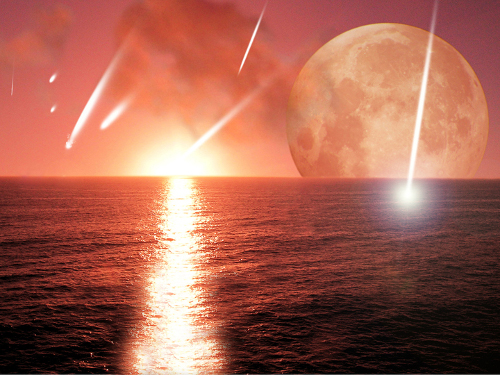
Image: Astronomers have theorized that long-ago asteroid impacts delivered much of the water now filling Earth’s oceans, as shown in this artist’s conception. If true, the stirring provided by migrating planets may have been essential to bringing those asteroids into play. Credit: David A. Aguilar (CfA).
Planetary migration may have brought Jupiter as close to the Sun as Mars is now, scouring the asteroid belt to leave little more than a tenth of one percent of its original population. Such migrations would have stirred the entire system, so that objects collected in the asteroid belt with origins as varied as close solar orbits to the distant realm of Neptune. And if this is the case, this shake-up of interplanetary materials may have delivered much of the water found in today’s oceans to Earth. This may be a key mechanism for bringing volatiles from beyond the snow line to warm but dry rocky worlds as planets capable of supporting life emerge elsewhere.
The paper is DeMeo and Carry, “Solar System evolution from compositional mapping of the asteroid belt,” Nature 505 (30 January 2014), pp. 629-634 (abstract).

Focus on the Nearest Brown Dwarfs
Luhman 16AB (otherwise known as WISE J104915.57-531906) holds out quite an allure for those of us hoping to see future exploratory missions to nearby interstellar space. As recounted here in December (see Possible Planet in Nearby Brown Dwarf System), the European Southern Observatory’s Henri Boffin has found that this brown dwarf pair is likely home to a previously undetected companion. Bear in mind that we know of no closer brown dwarf; indeed, Luhman 16AB is no more than 6.6 light years out, making it the third closest system to our Sun after Barnard’s Star and, of course, Alpha Centauri.
We know very little about this putative companion other than Boffin’s estimate that its likely mass is between a few Jupiter masses and perhaps as many as 30, but the good news is that the high end of this mass range should offer us an object that can be detected by adaptive optics, given the size of the apparent separation. In any case, radial velocity methods should work nicely here as well, given that as seen from Earth, the brown dwarf pairing appears nearly edge-on.
Now comes further news from the European Southern Observatory, with the announcement that one of the two brown dwarfs, Luhman 16B (WISE J104915.57-531906.1B) shows variations in brightness as it rotates, giving us strong hints of detectable features in its atmosphere. Using ESO’s Very Large Telescope, a team of researchers has mapped out the light and dark areas on Luhman 16B, observing the brown dwarf pair with the CRIRES instrument on the VLT (CRIRES is a high-resolution infrared spectrograph). The resulting ‘map’ appears below.
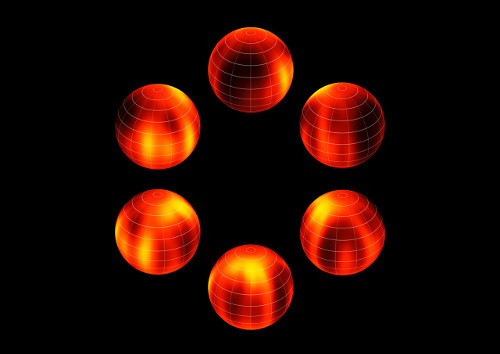
Image: ESO’s Very Large Telescope has been used to create the first ever map of the weather on the surface of the nearest brown dwarf to Earth. An international team has made a chart of the dark and light features on WISE J104915.57-531906.1B, which is informally known as Luhman 16B and is one of two recently discovered brown dwarfs forming a pair only six light-years from the Sun. The figure shows the object at six equally spaced times as it rotates once on its axis. Credit: ESO/I. Crossfield.
Ian Crossfield (Max Planck Institute for Astronomy) is lead author of the paper on this work, which will appear in Nature:
“Previous observations suggested that brown dwarfs might have mottled surfaces, but now we can actually map them. Soon, we will be able to watch cloud patterns form, evolve, and dissipate on this brown dwarf — eventually, exometeorologists may be able to predict whether a visitor to Luhman 16B could expect clear or cloudy skies.”
‘Exometeorologist’ — yet another new job description spawned by this golden age of exoplanetary exploration!
You can see where this is heading. As we learn more about the weather patterns on brown dwarfs, we are moving toward theoretical models which can be tested against future observations. When next-generation telescopes like the European Extremely Large Telescope come online, we can anticipate eventually creating similar maps for young gas giants. In none of these worlds should we expect clement weather: The clouds Crossfield’s team detected show temperatures in the range of 1100 degrees Celsius and are likely carrying droplets of molten iron and various minerals adrift in an atmosphere made up largely of hydrogen.
Crossfield’s map is complemented by a second study led by Beth Biller (University of Edinburgh), which observed brightness variations at different wavelengths in an attempt to understand what happens in various layers of the atmosphere on both Luhman 16A and 16B. This team drew its data from the 2.2 meter telescope at ESO’s La Silla observatory in Chile. Measurements were made in seven different filter bands, where emissions are correlated with the temperature of the emitting gas. Thus the different wavelengths probably represent layers at different depths within the brown dwarf’s atmosphere, constituting a kind of atmosphere probe.
The resulting paper appears in Astrophysical Journal Letters. According to this MPIA news release, this investigation marks the first simultaneous monitoring of a brown dwarf’s brightness variability in more than two wavelength ranges. Says Biller:
“We’ve learned that the weather patterns on these brown dwarfs are quite complex. The cloud structure of the brown dwarf varies quite strongly as a function of atmospheric depth and cannot be explained with a single layer of clouds.”
So we wind up with brown dwarfs with multiple cloud layers and/or temperature variations as we push ahead with the effort to understand weather patterns in distant solar systems. Keep in mind we are dealing with a place that is only slightly farther from the Earth than Barnard’s Star. If the companion object is eventually confirmed as a planet, Luhman 16AB will have the second closest exoplanet to Earth yet detected (assuming Centauri Bb is also confirmed). It will be an exciting period ahead as we try to learn what other objects may circle the nearest stars.
The mapping of Luhman 16B is described in Crossfield et al., “A Global Cloud Map of the Nearest Known Brown Dwarf,” about to appear in Nature (30 January 2014). See this ESO news release for more on that finding. Beth Biller and team’s work is found in Biller et al., “Weather on the Nearest Brown Dwarfs: Resolved Simultaneous Multi-Wavelength Variability Monitoring of WISE J104915.57-531906.1AB” in Astrophysical Journal Letters, Volume 778, Issue 1, L10.

An Intergalactic River of Hydrogen?
NGC 6946, the so-called ‘Fireworks Galaxy,’ has caught the eye of many an astronomer, even if its position — close to the plane of the Milky Way and thus partially obscured by gas and dust — makes the observation difficult. At 22 million light years from Earth, this face-on spiral galaxy has been the site of eight supernovae in the past century. I’m thinking about supernovae because SN 2014J, a supernova a scant 12 million light years away in M82, has been much in the news in recent days. But NGC 6946 is also intriguing because of the active pace of star formation there. What sustains a galaxy like this and keeps its star formation robust?
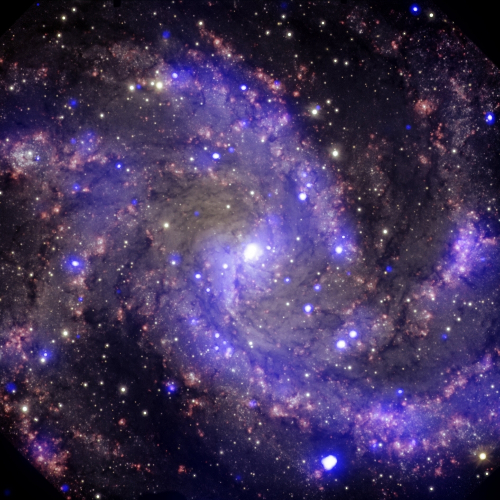
Image: The spiral galaxy NGC 6946. Observations from the Chandra spacecraft have revealed three of the oldest supernovas ever detected in X-rays here. This composite image also includes optical data from the Gemini Observatory in red, yellow, and cyan. Credit: X-ray: NASA/CXC/MSSL/R.Soria et al, Optical: AURA/Gemini OBs.
Now D. J. Pisano (West Virginia University) has discovered what appears to be a flow of hydrogen through intergalactic space, a gaseous filament streaming into NGC 6946 that can explain its active engine of star formation. Pisano puts the find in context:
“We knew that the fuel for star formation had to come from somewhere. So far, however, we’ve detected only about 10 percent of what would be necessary to explain what we observe in many galaxies. A leading theory is that rivers of hydrogen – known as cold flows – may be ferrying hydrogen through intergalactic space, clandestinely fueling star formation. But this tenuous hydrogen has been simply too diffuse to detect, until now.”
Galaxies where the rate of star formation is highest are known as ‘starburst’ galaxies, their activity considered a phase of the galaxy’s evolution. M82, site of the recent supernova, ranks as one of these. NGC 6946 can’t claim that level of activity, but the galaxy — found in the night sky between the constellations Cepheus and Cygnus — is a good deal more active than our relatively sedate Milky Way. And while an extended hydrogen halo has previously been observed in NGC 6946, the likely result of intense star formation and supernova explosions, what Pisano has discovered comes from a different source — intergalactic space.
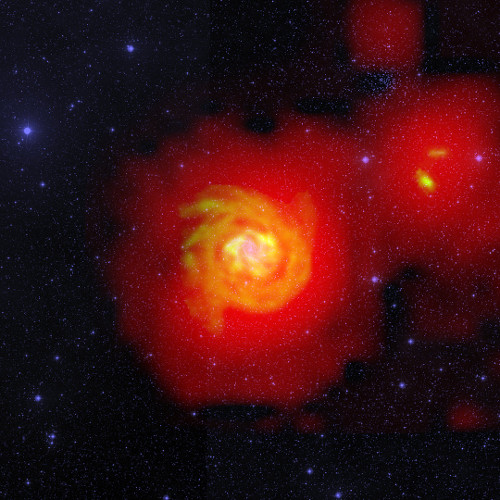
Image: This composite contains three distinct features: the bright star-filled central region of galaxy NGC 6946 in optical light (blue), the dense hydrogen tracing out the galaxy’s sweeping spiral arms and galactic halo (orange), and the extremely diffuse and extended field of hydrogen engulfing NGC 6946 and its companions (red). The new GBT data show the faintly glowing hydrogen bridging the gulf between the larger galaxy and its smaller companions. This faint structure is precisely what astronomers expect to appear as hydrogen flows from the intergalactic medium into galaxies or from a past encounter between galaxies. Credit: D.J. Pisano (WVU); B. Saxton (NRAO/AUI/NSF); Palomar Observatory – Space Telescope Science Institute 2nd Digital Sky Survey (Caltech); Westerbork Synthesis Radio Telescope
Working with the Green Bank Telescope, Pisano was able to uncover the signature of neutral hydrogen gas that had eluded other instruments. A steady flow of cold hydrogen could explain why larger galaxies are able to maintain their activity as they draw star-forming material from less massive neighbor galaxies. But Pisano can’t rule out the possibility that the gaseous fields shown in the image above could also be the result of an encounter with another galaxy in the distant past, one that left a ribbon of star-forming hydrogen behind. From the paper:
The best way to identify cold flows is statistically via a large survey. Cold flows should preferentially exist around low mass galaxies in low density environments. Tidal debris, on the other hand, should exist preferentially around galaxies in high density environments. Galactic outflows should preferentially exist around galaxies with low masses and large star formation rates. The ideal H I survey would span a wide range of galaxy mass, environment, and star formation rates to discriminate between these different origins.
Such a survey is precisely what Pisano now has in progress, with results to be announced in the near future. Given that the observed rate of hydrogen accretion in nearby galaxies is only ten percent of what would be needed to maintain star formation, we have a lot to learn about how galaxies sustain themselves. The work has also identified an extended disk around the galaxy NGC 2997 and its satellite galaxies, but no filamentary structures of the kind found at NGC 6946, where the hydrogen flow is evidently connected with the nearest satellite galaxies.
The paper is Pisano, “Green Bank Telescope observations of low column density HI around NGC 2997 and NGC 6946,” Astronomical Journal Vol. 147, No. 3 (2014), p. 48 (preprint / abstract).

What Makes a Planet ‘Superhabitable’?
Friday’s look at habitable zones, and the possibilities of life below the surface or in the atmosphere of an exoplanet, segues naturally into the fascinating notion of ‘superhabitable’ worlds. René Heller (McMaster University) and John Armstrong (Weber State University) ponder the possibilities in a recent paper for Astrobiology. What if, the scientists ask, our notions of habitability are too closely crafted to our own anthropocentric viewpoint? Could there be planets that are actually more habitable than the Earth? Should the Earth itself be considered, with respect to a broader view of biology, only marginally habitable?
The question has important ramifications for how we approach the search for other habitable worlds. We study extremophilic life forms on Earth and question whether conditions even more bizarre than these could still produce life. But Heller and Armstrong reframe the issue:
The word ‘bizarre’ is here to be understood from an anthropocentric point of view. From a potpourri of habitable worlds that may exist, Earth might well turn out as one that is marginally habitable, eventually bizarre from a biocentric standpoint. In other words, it is not clear why Earth should offer the most suitable regions in the physicochemical parameter space that can be tolerated by living organisms. Such an anthropocentric assumption could mislead research for extrasolar habitable planets because planets could be non-Earth-like but yet offer more suitable conditions for the emergence and evolution of life than Earth did or does; that is, they could be superhabitable.
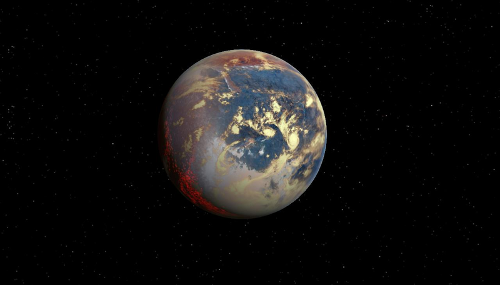
Image: A super-Earth, as depicted in this artist’s impression of HD 215497 b, could actually be more ‘habitable’ than the Earth, according to Heller and Armstrong’s new work, which re-examines our ideas about the conditions needed for life. Credit: Wikimedia Commons.
Heller and Armstrong stick with liquid water as a prerequisite for life, so their extrapolations are incremental, but the proposal to enter a new word into the lexicon is bold enough. So let’s consider what ‘superhabitability’ might mean. One possibility is that a larger world (though not large enough to cause plate tectonics to cease) could offer more spacious conditions for life’s development. Planets with what the duo call ‘fractionate continents and archipelagos’ should produce a wider diversity of habitats, their spacious shallow waters offering higher biodiversity than Earth’s deep oceans. The paper leans toward dry planets with a lower fractional surface coverage of water, where liquid water is abundant but distributed into many reservoirs.
The elements of superhabitability multiply. Plate tectonics allow us to speculate on super-Earths with masses up to about two Earth masses. Beyond this, high pressures in the mantle reduce the likelihood of tectonic activity (the two Earth masses used here is a deliberately conservative figure). Also needed: An intrinsic magnetic field produced by a liquid, rotating, convecting core to protect the planet from high-energy cosmic radiation. And the biodiversity of Earth seems to multiply in periods of warmer conditions, suggesting that a warmer version of Earth might have extended tropical zones and, over the course of aeons, a greater variance in biological forms.
The factors at play in Heller and Armstrong’s speculations make for interesting scenarios. Imagine a solar system with more than a single terrestrial planet or moon in the habitable zone. More even distribution between the Earth and the Moon would have resulted in a double-planet, with both objects habitable. Or imagine switching Mars and Venus, to potentially produce three habitable planets. Some systems, indeed, might be ‘multihabitable,’ with massive moons around gas giants and the possibility of panspermia within the system to spread local biology.
Or ponder moving the Earth, which some recent work describes as being at the very inner edge of the Sun’s habitable zone. A terrestrial world located closer to the center of the HZ could be considered superhabitable because it would be more resistant to runaway greenhouse states than the Earth is. Or perhaps age is itself a condition for superhabitability. Heller and Armstrong make the case that the Earth experienced greater biodiversity as it aged — thus the introduction of oxygen about 2.5 billion years ago (from oceanic algae) led to greater habitability on the surface, allowing life to move onto the continents, an increase in planetary habitability.
And what of the star the planet orbits? The authors see K stars as offering a compromise between initial and long-term high-energy radiation, making them favorable hosts for superhabitable worlds. From the paper:
Higher biodiversity made Earth more habitable in the long term. If this is a general feature of inhabited planets, that is to say, that planets tend to become more habitable once they are inhabited, a host star slightly less massive than the Sun should be favorable for superhabitability. These so-called K-dwarf stars have lifetimes that are longer than the age of the Universe. Consequently, if they are much older than the Sun, then life has had more time to emerge on their potentially habitable planets and moons, and — once occurred — it would have had more time to ‘tune’ its ecosystem to make it even more habitable.
That, of course, gets us to the K-class star we have so often discussed in these pages, Alpha Centauri B. We already have one planetary candidate around it, an Earth-mass planet in a 3.235-day orbit. In terms of age, recent work based on asteroseismology, chromospheric activity and other means shows it to be a bit older than the Sun, with estimates ranging from 4.85 billion years up to about 6.5 billion. The authors note that a planet in the habitable zone around this star, collecting water from objects beyond the snowline, could have had primitive life forms when the Earth had just collided with the Mars-sized object that would be responsible for the Moon.
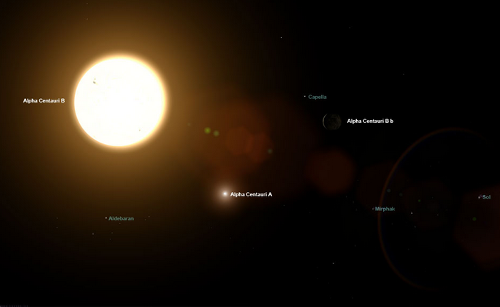
Image: Artist’s impression of Alpha Centauri B, with Centauri A in the distance and the planet candidate Centauri B b also marked. Credit: Adrian Mann.
Heller and Armstrong note that our exoplanet studies have shown us that the Solar System is anything but typical when it comes to planetary systems, so it may well be that the Earth is itself atypical when it comes to inhabited worlds. In that sense — and they make this point specifically — their work refutes the Ward and Brownlee ‘rare Earth hypothesis’ that saw life as an extremely unlikely phenomenon emerging from a wide range of precise conditions. Perhaps what Ward and Brownlee are seeing, says this new work, is the emergence of an only marginally habitable world. If so, our search for inhabited planets should take in worlds slightly older and slightly more massive than our own, preferably those orbiting K-class stars like the close-by Centauri B.
Can we create a biocentric model to use in our search for habitable worlds that replaces our anthropocentric expectations? This paper makes a spirited run at the idea. The paper is Heller and Armstrong, “Superhabitable Worlds,” Astrobiology Vol. 14, No. 1 (2014), available online. The work is thick with ideas, and I didn’t have time today to go into the ‘terrestrial menagerie’ discussed in its first part, which shows not only how planets in the habitable zone can be rendered uninhabitable but how exomoons beyond the HZ may be rendered life-bearing. I suspect, though, that we’ll be coming back to these arguments again soon. Thanks to the numerous readers who forwarded links to this paper.

Astrobiology Underground
I’m a great believer in what I might call the ‘conventional’ habitable zone; i.e., a habitable zone defined by the possibility of liquid water on the surface. The definition is offered not to exclude exotic possibilities like micro-organisms floating in the clouds of Venus or aquatic life deep inside an ice-covered moon like Europa. Rather, it acknowledges that finding life is hard enough without losing our focus. In terms of exoplanets and feasible near-term study, a warm planet with liquid water — the kind we live on — would command our immediate attention.
But as we look at much broader issues of how life forms, we may indeed learn that our kind of life is but one component of a vast continuum, as recent work out of the University of Aberdeen reminds us. In a new paper published in Planetary and Space Science, researchers tackle the question of life living deep underground. Now the habitable zone starts to broaden, because things get warmer as we go deep.
We know of life here on Earth that exists more than five kilometers below the surface, and given the difficulty of probing these regions, we probably have fragmentary knowledge at best of what’s down there at deeper levels. So if we’re talking underground microorganisms, maybe a place like Gliese 581 d, evidently just past the outer edge of its star’s habitable zone in terms of liquid water, would still qualify. The Aberdeen team thinks conditions less than two kilometers below the surface there could be clement.
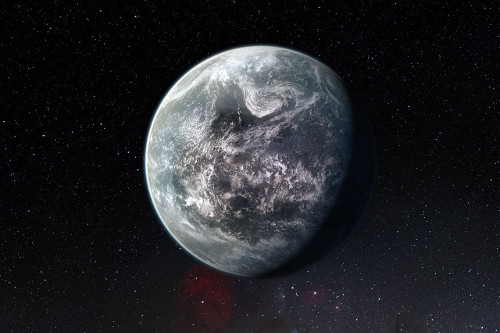
Image: New studies are examining habitable conditions below planetary surfaces, where liquid water might exist. Internal heat might keep even a ‘rogue’ planet moving without a parent star capable of hosting some kind of life underground. This image is an artist’s impression of the rocky super-Earth HD 85512 b. Credit: European Southern Observatory.
The Aberdeen work revolves around a computer model that estimates the temperature below the surface of planets of varying sizes at varying distances from their star. Doctoral student Sean McMahon comments on the implications in this Aberdeen news release:
“Using our computer model we discovered that the habitable zone for an Earth-like planet orbiting a sun-like star is about three times bigger if we include the top five kilometres below the planet surface. The model shows that liquid water, and as such life, could survive 5km below the Earth’s surface even if the Earth was three times further away from the sun than it is just now. The results suggest life may occur much more commonly deep within planets and moons than on their surfaces. If we go deeper, and consider the top 10 km below the Earth’s surface, then the habitable zone for an Earth-like planet is 14 times wider.”
An extension of the habitable zone indeed, taking us well past the orbit of Saturn in our own Solar System. And ponder the case of a rogue ‘super-Earth,’ a planet four or five times more massive than the Earth that has for whatever reason been ejected into the interstellar deep. We’ve talked about such places before and their prospects for generating enough internal heat to make some kind of life possible even in the absence of a parent star. And when you start extending habitable zones this far, a cosmos teeming with at least primitive life seems possible.
Since we’re pushing habitable zones in new directions, let me also mention Craig Stark (University of St. Andrews), whose work has focused on alien atmospheres extending from exoplanets to brown dwarfs. Stark argues that prebiotic molecules can form in these environments, saying “The atmospheres around exoplanets and brown dwarfs form exotic clouds that, instead of being composed of water droplets, are made of dust particles made of minerals.” Add a dose of lightning and you have charged particles and interesting possibilities:
“These charged gases are called plasmas – like those found in fluorescent lights and plasma televisions. The dust can find itself immersed in the charged gases and the charged particles stick to the dust making the dust charged. The charged dust attracts onto its surface other charges from the surrounding plasma helping grow molecules on the dust surface.”
The precursors to life in the atmosphere of a brown dwarf? Now we’re really pushing the definition of ‘habitable zone.’ The Stark paper is “Electrostatic activation of prebiotic chemistry in substellar atmospheres,” accepted at The International Journal of Astrobiology (preprint). The McMahon paper is “Circumstellar habitable zones for deep terrestrial biospheres,” Planetary and Space Science Vol. 85 (September, 2013), pp. 312-318 (abstract).

The Plumes of Ceres
The MACH-11 program (Measurements of 11 Asteroids and Comets Using Herschel) uses data from the European Space Agency’s space-based Herschel observatory to look at small bodies that are targeted by our spacecraft. With the Dawn mission on its way to Ceres, the Herschel data have now revealed the existence of water vapor on the dwarf planet. To my knowledge, this is the first time water vapor has been detected in an asteroid, or I should say, an object that used to be considered an asteroid before the International Astronomical Union decided to re-classify it because of its large size.
Herschel ran out of coolant in the spring of 2013, but not before making a series of observations of Ceres in the two previous years that show a thin water vapor atmosphere. As with so many of our missions (Kepler comes immediately to mind), we still have plentiful data to look through. In this case, we’ll be examining the increasingly fuzzy distinction between asteroids and comets as we try to figure out precisely what is happening on Ceres. Dawn’s investigations, with arrival in March of 2015 and studies continuing all that year, will obviously provide a much closer look.
Carol Raymond is deputy principal investigator for Dawn at the Jet Propulsion Laboratory:
“We’ve got a spacecraft on the way to Ceres, so we don’t have to wait long before getting more context on this intriguing result, right from the source itself. Dawn will map the geology and chemistry of the surface in high resolution, revealing the processes that drive the outgassing activity.”
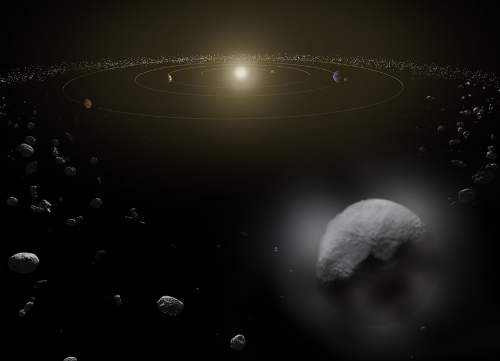
Image: Dwarf planet Ceres is located in the main asteroid belt, between the orbits of Mars and Jupiter, as illustrated in this artist’s conception. Observations by the Herschel space observatory between 2011 and 2013 have revealed the first unambiguous detection of water vapor around an object in the asteroid belt. Credit: JPL/Caltech.
Finding water vapor is not totally unexpected, given the long-standing assumption that Ceres contains a mantle of ice in its interior, one that may include as much as 200 million cubic kilometers of water, more than the amount of fresh water on Earth. Herschel’s work in the far infrared is what it took to make the call, complicated by the fact that the signature proved to be elusive. This JPL news release notes the emerging view that Ceres releases water vapor in plumes at about 6 kilograms per second when orbiting closer to the Sun, while remaining frozen tight when further out.
Thomas Müller (Max Planck Institute for Extraterrestrial Physics) discusses the finding in an MPE release:
“The intensity of the water line is linked to certain dark regions on the surface; these are either warmer areas or craters where an impact has exposed some layers of ice deeper down. Moreover, we were able to track how the amount of water changes along the asteroid’s way around the sun: if it passes nearer to the sun the water signature increases and then decreases again in the more remote sections of its orbit.”
Dawn will have specific targets to examine when it arrives thanks to the Herschel work, because the space observatory was able to see how the strength of the water vapor signature varied over time as Ceres spun on its axis. Those dark areas that Müller talks about had also been identified by earlier Hubble observations, and those of ground-based telescopes as well. Clearly, we’ll count on Dawn to teach us a lot more about them and how they operate, just as we used Cassini to investigate the geyser activity on Enceladus. The plumes of Ceres are going to get plenty of attention in the year ahead.


